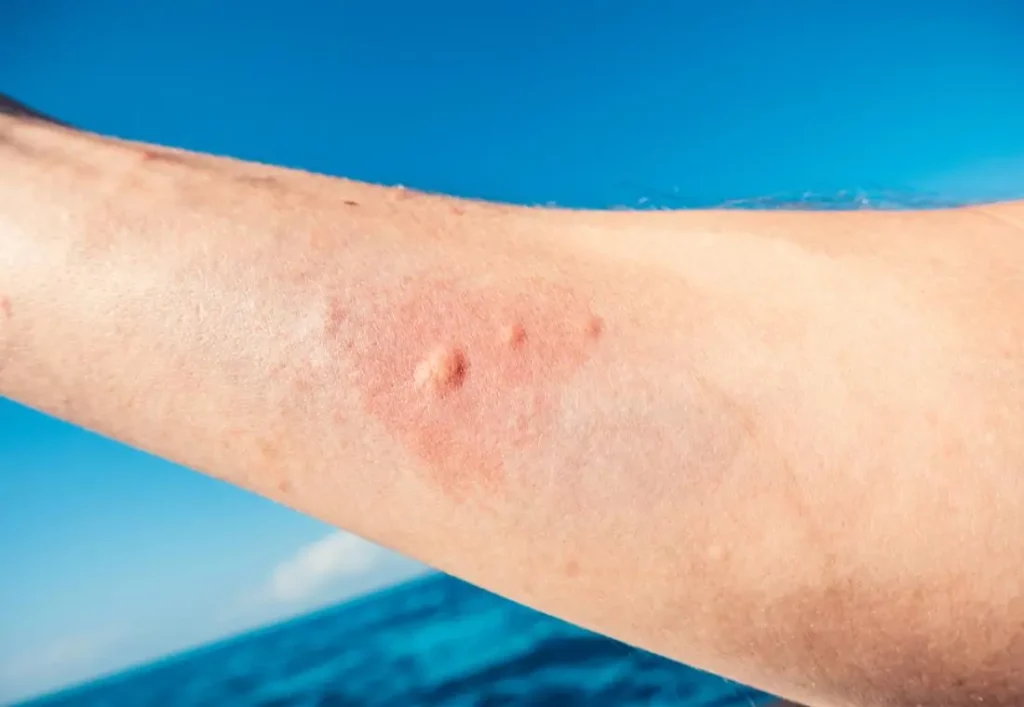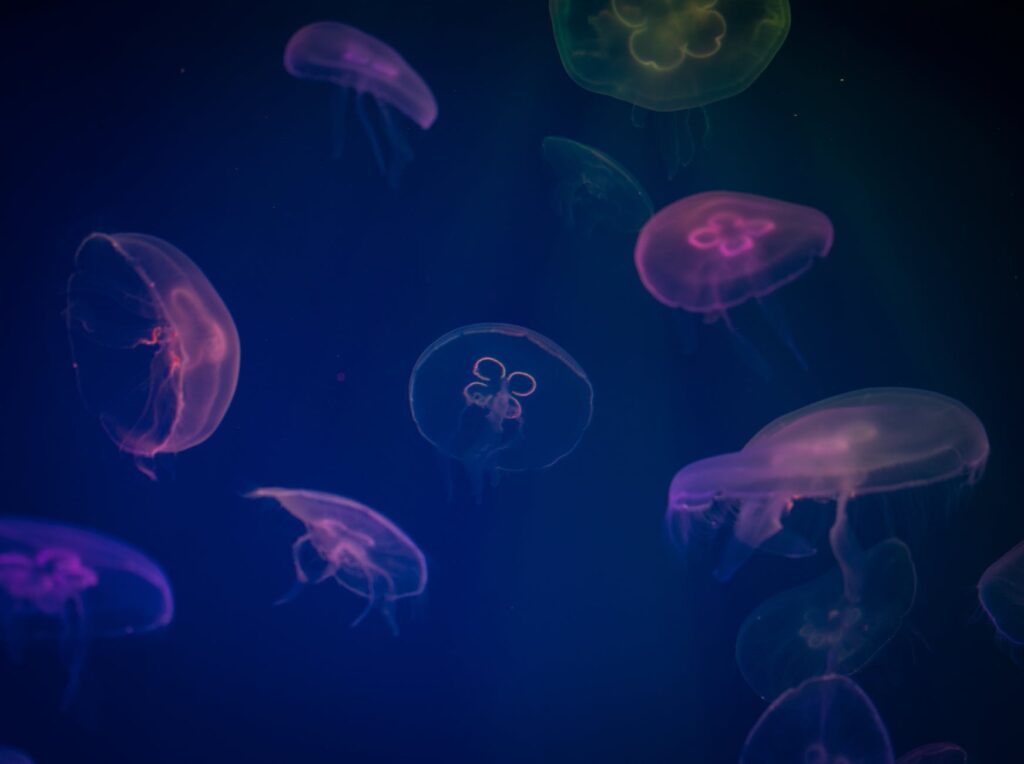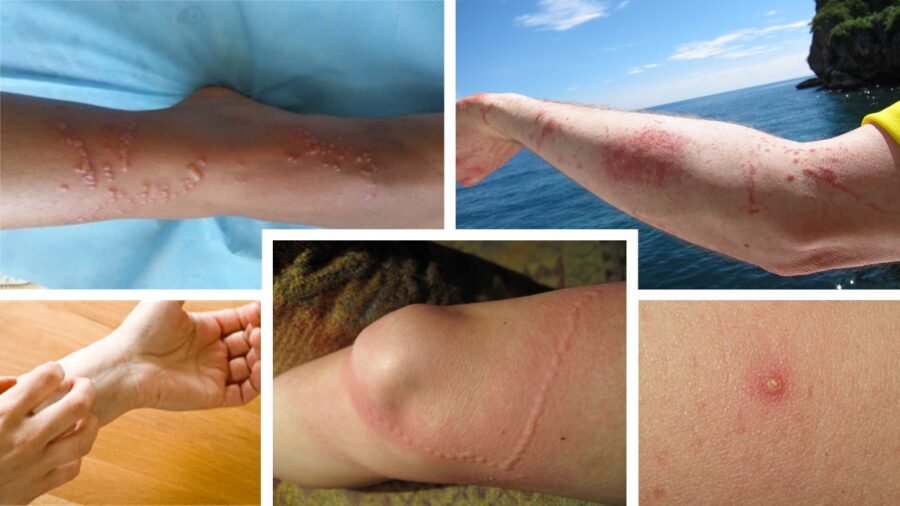What To Do If A Jellyfish Stings You? Essential Steps for Quick Relief
You’re enjoying a sunny day at the beach, basking in the joy of the ocean’s embrace, when suddenly, a jellyfish sting interrupts your blissful escape. Panic sets in, and you find yourself asking, “What to do if a jellyfish stings you?”
Jellyfish stings can be distressing, with their venomous tentacles causing pain, redness, itching, and swelling. In more severe cases, you may experience allergic reactions or encounter highly dangerous species that require immediate medical attention.
In this comprehensive guide, we will discuss the step-by-step actions to take if a jellyfish stings you. Starting with the immediate first aid required, we will explain the importance of rinsing the affected area with seawater and removing any tentacles. Read on.
What To Do If A Jellyfish Stings You?
If a jellyfish stings you, prompt action is crucial. First and foremost, remove yourself from the water to prevent further stings and ensure your safety. Knowing the correct steps to follow can help minimize discomfort and promote faster healing.
Here is what to do if a jellyfish stings you:
1. Get out of the water: Move away from the jellyfish to avoid getting stung again and ensure your safety.
2. Rinse with seawater: Use seawater to rinse the affected area. This helps to remove any remaining tentacles or stinging cells. Avoid using freshwater, as it can activate the stinging cells and make the situation worse.
3. Remove tentacles (optional): If there are visible tentacles on your skin, you can carefully remove them using tweezers or a glove-protected hand. Be cautious not to touch them directly with your bare hands to avoid further stings.
4. Apply vinegar or a baking soda slurry: Vinegar can help deactivate the stinging cells of some jellyfish species. If vinegar is not available, you can make a paste using baking soda and seawater. Apply the vinegar or baking soda slurry to the affected area for about 15-30 minutes.
5. Use hot water or cold packs: To relieve pain and reduce swelling, you can either immerse the affected area in hot water (not scalding) for around 20 minutes or apply a cold pack wrapped in a cloth.
6. Take over-the-counter pain relievers: If you experience pain or discomfort, you can consider taking over-the-counter pain relievers like acetaminophen or ibuprofen. Follow the recommended dosage instructions.
7. Seek medical attention if necessary: If you have been stung by a potentially dangerous species, such as a box jellyfish or Portuguese man-of-war, or if you are experiencing severe symptoms like difficulty breathing, chest pain, or signs of an allergic reaction, seek immediate medical assistance.
It is crucial to prioritize your safety and seek medical attention when needed. This general advice can help in most cases, but the severity of jellyfish stings can vary, so it’s always best to consult a healthcare professional if you have any concerns.
Types Of Jellyfish Stings (What To Do If A Jellyfish Stings You)
When it comes to jellyfish stings, it’s crucial to understand that different types of jellyfish can produce varying levels of sting severity.
Being able to identify the specific type of jellyfish that stung you can greatly assist in determining the most appropriate course of treatment. Let’s explore some common types of jellyfish stings and their respective characteristics:
1. Box Jellyfish
Box jellyfish stings are considered one of the most dangerous. Found in tropical and subtropical waters, they possess long, slender tentacles equipped with numerous venomous cells.
Their sting can cause excruciating pain, severe skin reactions, and potentially life-threatening complications, including cardiac and respiratory issues.
2. Portuguese Man-of-War
Although technically not a jellyfish, the Portuguese Man-of-War is often mistaken for one. It consists of a floating blue or purple bladder with long, venomous tentacles hanging below.
Its sting can lead to intense pain, redness, swelling, and even systemic symptoms such as difficulty breathing or heart palpitations.
3. Sea Nettle
Sea nettles are commonly found in coastal regions and have long, trailing tentacles covered in stinging cells. While their stings can be painful, they are typically not as severe as those from box jellyfish or Portuguese Man-of-War. Symptoms may include redness, itching, and localized skin irritation.
4. Lion’s Mane Jellyfish
Lion’s Mane jellyfish are known for their striking appearance, with long, flowing tentacles. Their stings can cause varying degrees of pain and skin irritation. In some cases, you may experience allergic reactions or systemic symptoms such as nausea or muscle cramps.
5. Moon Jellyfish
Moon jellyfish, commonly encountered in coastal waters, have delicate, translucent bodies and short, harmless tentacles. Their stings are usually mild, resulting in minor skin irritation, redness, and itching. Most moon jellyfish stings can be managed with basic first aid measures.
These are just a few examples of jellyfish species and their associated stings. It is always best to consult a healthcare professional or local marine experts for precise identification and tailored treatment recommendations.
By understanding the different types of jellyfish stings and their varying severity, you can take appropriate actions and seek the necessary medical attention, if required. Stay informed and prepared to ensure your safety and well-being in the face of a jellyfish encounter.

Symptoms of Jellyfish Sting
The symptoms of a jellyfish sting can vary depending on factors such as the type of jellyfish, the amount of venom injected and your sensitivity to the venom. Here are common symptoms associated with jellyfish stings:
1. Pain: Jellyfish stings often cause immediate and intense pain at the site of contact. The level of pain can range from mild discomfort to severe, depending on the severity of the sting.
2. Redness and swelling: The affected area may become red, swollen, and inflamed around the site of the sting. This localized reaction is a typical response to the venom.
3. Itching and irritation: Itching is a common symptom that accompanies jellyfish stings. The skin around the sting site may feel irritated, leading to a persistent urge to scratch.
4. Rash or hives: Some individuals may develop a rash or hives in and around the area where the jellyfish tentacles made contact with the skin. This can be an allergic reaction to the venom.
5. Raised welts: Raised, welt-like lesions or a pattern of whip-like marks may appear on the skin. These marks correspond to the areas where the jellyfish’s tentacles made contact and released venom.
6. Numbness or tingling: In some cases, a jellyfish sting can cause numbness or tingling sensations in the affected area. This can be due to the action of the venom on nerve endings.
7. Systemic symptoms: For more severe jellyfish stings, systemic symptoms may occur. These can include nausea, vomiting, muscle cramps, headache, dizziness, weakness, and difficulty breathing. Systemic symptoms may indicate a more significant reaction or involvement of a dangerous species.
It’s important to note that jellyfish stings can affect individuals differently, and symptoms can vary in intensity and duration. If you or someone else experiences a jellyfish sting and exhibits severe symptoms or signs of an allergic reaction, it is essential to seek immediate medical attention.

How To Prevent Jellyfish Stings
Preventing jellyfish stings is key to enjoying your time in the water without encountering these potentially painful creatures. Here are some effective measures you can take to prevent jellyfish stings:
1. Stay informed: Before going to the beach or entering the water, check for local advisories or warnings regarding jellyfish presence. Keep an eye out for signs or information provided by lifeguards or local authorities.
2. Wear protective water shoes for jellyfish: There are many great water shoes to protect you from jellyfish stings. Get one for yourself.
2. Choose safe swimming areas: If possible, swim in designated areas that are monitored and have been deemed safe for swimming. These areas are often cleared of jellyfish or have protective barriers to minimize the risk of stings.
3. Wear protective clothing: Consider wearing protective clothing while swimming, such as rash guards, wetsuits, or full-body swimsuits. These can act as a barrier between your skin and any potential jellyfish stings.
4. Use sunscreen with jellyfish repellent: Look for sunscreens that specifically mention jellyfish repellent properties. Although not foolproof, they may provide an additional layer of protection against jellyfish encounters.
5. Swim with a buddy: It’s always a good idea to swim with a partner or in a group. In case of a jellyfish sting or any emergency, having someone nearby can provide immediate support and support.
6. Avoid stagnant water or jellyfish blooms: Jellyfish are often found in stagnant or still waters, so it’s best to avoid swimming in areas where water is not regularly refreshed, such as harbors or areas close to river mouths.
Additionally, be cautious when swimming during periods of jellyfish blooms, which are increased concentrations of jellyfish in a specific area.
7. Be cautious around floating objects: Jellyfish can sometimes be attracted to or found near floating objects, including buoys, debris, or patches of seaweed. Exercise caution when approaching or swimming around such objects.
8. After-sting prevention: If you have been stung by a jellyfish previously and are prone to allergic reactions, consider carrying a small bottle of vinegar or rubbing alcohol with you. If stung, rinsing the affected area with vinegar or rubbing alcohol can help deactivate any remaining stinging cells.
While these prevention methods can significantly reduce the risk of jellyfish stings, they do not guarantee complete avoidance. Always remain vigilant and aware of your surroundings, and if you spot jellyfish or experience a sting, take appropriate action to ensure your safety and well-being.
Jellyfish Sting Statistics. How Common Jellyfish Stings Are, And What The Potential Complications Of A Jellyfish Sting Can Be
Understanding the prevalence of jellyfish stings and the potential complications associated with them can help raise awareness and promote a proactive approach to prevention and treatment.
Let’s explore some statistics on jellyfish stings:
- It is estimated that 150 million people are stung by jellyfish each year.
- The most common jellyfish stings occur in warm tropical waters, but jellyfish can be found in all oceans of the world.
- The box jellyfish, found in the Indo-Pacific region, is the most venomous jellyfish in the world.
- The symptoms of a jellyfish sting can vary depending on the type of jellyfish and the severity of the sting.
- Mild stings may cause pain, redness, and swelling.
- More serious stings can cause nausea, vomiting, headache, difficulty breathing, and even death.
If you are stung by a jellyfish, it is important to seek medical attention immediately, especially if you experience any of the more serious symptoms.
Here are some additional information on the symptoms and treatment of more serious jellyfish stings:
- Symptoms of a serious jellyfish sting can include:
- Severe pain
- Redness and swelling
- Nausea and vomiting
- Headache
- Difficulty breathing
- Dizziness
- Shock
If you are stung by a jellyfish, it is important to stay calm and seek medical attention immediately. With prompt treatment, most jellyfish stings are not serious and will resolve within a few hours. However, some stings can be life-threatening, so it is important to seek medical attention as soon as possible.

Where To Find Jellyfish
Jellyfish are indeed found in oceans across the globe, but their distribution can vary, and some regions are more prone to jellyfish encounters than others.
Here are some areas where jellyfish are more likely to be found:
- Tropical and subtropical waters: Jellyfish are most common in warm, tropical and subtropical waters. This includes areas such as the Caribbean Sea, the Gulf of Mexico, the Mediterranean Sea, the Indian Ocean, and the Pacific Ocean.
- Coastal areas: Jellyfish are also more common in coastal areas than in open ocean. This is because coastal areas tend to have warmer water and more nutrients, which attract jellyfish.
- Areas with high currents: Jellyfish are often found in areas with high currents. This is because the currents help to disperse jellyfish larvae and bring them to new areas.
- Areas with low visibility: Jellyfish are more difficult to see in areas with low visibility, such as murky water or at night. This is because their bodies are often transparent or translucent.
Here are some specific areas where jellyfish are known to be a problem:
- Australia: Australia has a high number of jellyfish species, and some of the most venomous jellyfish in the world can be found there. The most dangerous jellyfish in Australia is the box jellyfish, which can be found in the northern coastal waters of the country.
- Florida: Florida is home to a variety of jellyfish species, including the Portuguese man-of-war. The Portuguese man-of-war is known for its long, trailing tentacles, which can deliver a painful sting.
- California: California has a number of jellyfish species, including the sea nettle, which is one of the most common jellyfish in the world. The sea nettle can deliver a painful sting, but it is not considered to be as dangerous as some other jellyfish species.
How To Cure A Jellyfish Sting With Pee
The belief that urine can be used to treat jellyfish stings is a common myth that has circulated for many years. However, it is important to note that using urine to treat a jellyfish sting is not a reliable or recommended method. In fact, it can potentially worsen the situation.
The best way to treat a jellyfish sting is to rinse the affected area with seawater as soon as possible. This will help to remove any remaining tentacles and deactivate the venom. You can also use a credit card or other blunt object to scrape away any remaining tentacles.

How To Treat A Jellyfish Sting At The Beach (What To Do If A Jellyfish Stings You)
Treating a jellyfish sting at the beach requires immediate action to alleviate discomfort and minimize the potential for complications. Here’s how to effectively treat a jellyfish sting at the beach:
1. Get out of the water and move away from the jellyfish.
2. Rinse the sting with seawater, avoiding freshwater.
3. Remove tentacles, if visible, using a glove-protected hand.
4. Apply vinegar or a baking soda slurry to neutralize the venom.
5. Use hot water to alleviate pain and swelling.
6. Consider taking over-the-counter pain relievers.
7. Seek medical attention if the sting is from a dangerous species or if severe symptoms occur.
8. Monitor for allergic reactions or worsening symptoms.
9. Stay hydrated and avoid scratching the sting.
10. Keep the area clean and dry to prevent infection.
Remember, if in doubt or if symptoms worsen, always seek professional medical help for appropriate care and treatment.
Why Is My Jellyfish Sting Itching A Week Later
Itching from a jellyfish sting that persists for a week or longer could be attributed to various factors. Here are a few possible explanations:
1. Delayed reaction: Some individuals may experience delayed allergic reactions to jellyfish stings. Itchiness that persists for an extended period could be a result of the body’s immune response to the venom. In these cases, the itching may continue beyond the initial acute phase of the sting.
2. Ongoing inflammation: Jellyfish venom can cause inflammation in the skin, leading to prolonged itchiness. Inflammation can persist for an extended period, especially if the sting was more severe or if the individual has heightened sensitivity to the venom.
3. Secondary infection: If the sting site becomes infected, it can cause prolonged itching. Bacteria may enter the skin through an open wound created by the sting, leading to an infection that can manifest as persistent itching.
4. Allergic dermatitis: In some cases, individuals may develop allergic dermatitis as a reaction to the venom. This condition can cause ongoing itchiness, redness, and inflammation at the site of the sting.
5. Skin irritation or sensitivity: The skin around the sting site may remain sensitive or irritated for an extended period, leading to continued itchiness. This sensitivity can be influenced by individual factors such as skin type and previous skin conditions.
If you are experiencing persistent itching a week after a jellyfish sting, it is advisable to consult a healthcare professional or dermatologist. They can evaluate the symptoms, assess the sting site, and provide appropriate treatment or further guidance based on your specific situation.
Jellyfish Sting Treatment After A Week (What To Do If A Jellyfish Stings You)
If you are still experiencing discomfort or symptoms from a jellyfish sting after a week, it is recommended to seek medical advice. While most jellyfish stings resolve within a few days, persistent symptoms may indicate an underlying issue that requires attention. Here are a few considerations:
1. Consult A Healthcare Professional
Reach out to a healthcare professional, such as a doctor or dermatologist, who can examine the sting site and provide appropriate treatment. They may recommend topical medications, oral antihistamines, or other interventions to alleviate persistent symptoms.
2. Address Infection
If there are signs of infection, such as increased redness, swelling, warmth, or discharge from the sting site, it is essential to seek medical attention promptly.
Infections can occur when the sting site becomes contaminated with bacteria. Your healthcare provider may prescribe antibiotics or recommend appropriate measures to address the infection.
3. Allergic Reactions
If you are experiencing ongoing allergic reactions, such as persistent itching, redness, or swelling, it is important to consult a healthcare professional. They can assess the symptoms and provide appropriate treatment options, including antihistamines or corticosteroids, to manage the allergic response.
4. Wound Care
If the sting site has not fully healed, it is crucial to continue practicing proper wound care. Keep the area clean, apply an over-the-counter antibiotic ointment (if recommended by a healthcare professional), and cover it with a sterile dressing to protect against further irritation or infection.
So, the right treatment approach will depend on the nature and severity of your symptoms. A healthcare professional will be able to provide an accurate diagnosis and develop an appropriate treatment plan tailored to your situation.

Jellyfish Sting Treatment Vinegar (What To Do If A Jellyfish Stings You)
Vinegar is commonly recommended as a first-aid treatment for jellyfish stings. Here’s how you can use vinegar for jellyfish sting treatment:
1. Assess the situation: Ensure your safety by moving away from the jellyfish and out of the water to avoid further stings.
2. Rinse with seawater: Use seawater to rinse the affected area. This helps remove any tentacles or stinging cells. Avoid using freshwater, as it can activate the stinging cells and worsen the sting.
3. Apply vinegar: Once rinsed with seawater, apply vinegar directly to the sting site. It is recommended to use vinegar at full strength without dilution.
4. Soak for 15-30 minutes: Allow the vinegar to soak the affected area for about 15-30 minutes. This can help inactivating the stinging cells and neutralizing the venom.
5. Remove tentacles (optional): If there are visible tentacles on the skin, you can carefully remove them using tweezers or a glove-protected hand. Avoid touching them directly with bare hands to prevent additional stings.
6. Seek medical attention if necessary: If the sting is from a potentially dangerous species, or if you experience severe symptoms such as difficulty breathing, chest pain, or signs of an allergic reaction, seek immediate medical assistance.
Remember, if you have any doubts or concerns about a jellyfish sting, it is always best to consult a healthcare professional for appropriate care and guidance.

Other Marine Creature Stings
In addition to jellyfish, there are other marine creatures that can cause stings. It’s essential to be aware of their symptoms, first aid measures, and recommended treatments for a well-rounded understanding of marine creature stings. Here’s a brief overview:
1. Stingrays
Symptoms: Stingray stings often result in immediate intense pain, swelling, redness, and bleeding at the site of the sting. Some individuals may experience muscle cramps, weakness, nausea, or vomiting.
First aid and treatment
– Notify a lifeguard or seek medical help immediately.
– Keep the affected area immersed in hot water (as hot as tolerable) to help alleviate pain.
– Do not try to remove the barb if it is embedded in the skin. Medical professionals will handle this.
– Tetanus shot may be necessary if it has been more than 5 years since the last vaccination.
2. Sea Anemones
Symptoms: Sea anemone stings can cause immediate pain, redness, swelling, and localized skin irritation. Some individuals may also experience allergic reactions or develop a rash.
First aid and treatment
– Rinse the affected area with seawater to remove any remaining tentacles or stinging cells.
– Soak the area in hot water (as hot as tolerable) to help alleviate pain.
– Consider taking over-the-counter pain relievers if needed.
– Seek medical attention if symptoms worsen or an allergic reaction occurs.
3. Fire Corals
Symptoms: Fire coral stings typically cause immediate intense pain, redness, swelling, and itching. The affected area may develop a rash or blisters.
First aid and treatment
– Rinse the affected area with seawater to remove any tiny invisible hairs or particles.
– Apply vinegar or isopropyl alcohol to the sting site for about 15 minutes.
– Soak the area in hot water (as hot as tolerable) for pain relief.
– Take over-the-counter pain relievers if necessary.
– Seek medical attention if symptoms persist or worsen.
Remember, while these are general guidelines, it is crucial to seek medical help or consult with lifeguards or healthcare professionals for proper assessment and treatment of marine creature stings. They can provide specific guidance based on the individual case and circumstances.
The Bottom Line On What To Do If A Jellyfish Stings You
Knowing what to do if a jellyfish stings you is essential for your safety and well-being. Prompt action, such as removing yourself from the water, rinsing with seawater, and seeking appropriate first aid measures, can help alleviate the pain and minimize potential complications.
Remember, vinegar or a baking soda slurry can be applied, and hot water or cold packs can provide relief. If symptoms persist or worsen, seeking medical attention is crucial.
By being prepared and informed, you can confidently navigate the waters and enjoy the beach while staying vigilant and taking the necessary steps to handle a jellyfish sting effectively. Stay safe and enjoy your time at the beach!



